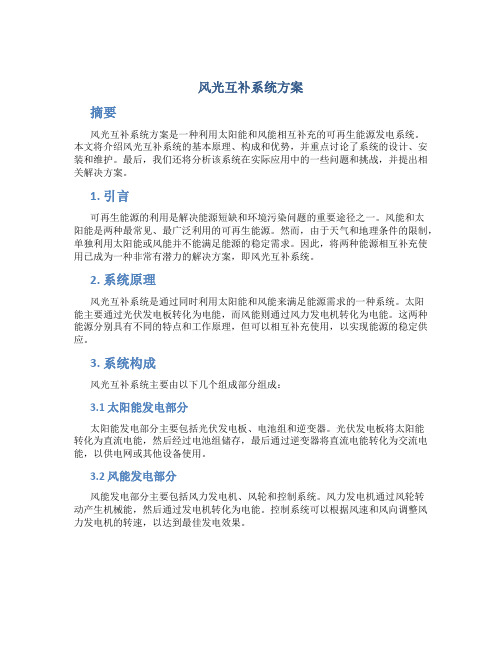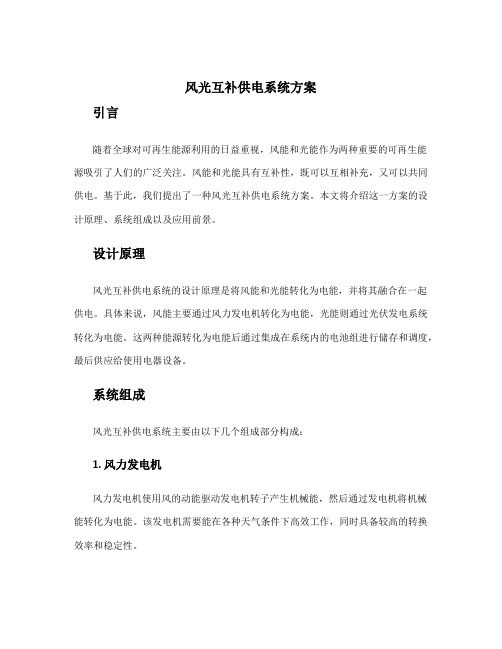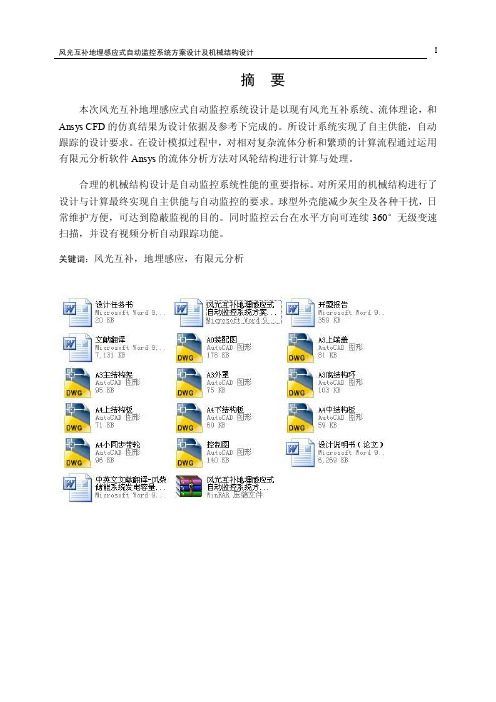风光互补地埋感应式自动监控系统方案设计及机械结构设计
基于风光互补发电实验平台的监控系统

基于风光互补发电实验平台的监控系统本文针对风光互补发电实验平台,对基于PLC的风/光/蓄一体的集中监控系统进行设计.其功能主要是对系统运行参数进行实时监控,包括采集和监测风光互补发电系统的运行情况,并将风光互补发电系统的运行数据实时记录和储存,使风光互补发电系统各部分协调、稳定工作,完成相应的各种功能,达到教学实验的目的。
标签:风;光;发电;实验;监控1 引言近年来,风能和太阳能的利用技术发展迅速,10年前,世界风光发电总功率不到100万kW,如今已超,过1000万kW。
据估计,20年内风光发电将可满足世界电力需求的10%,成为21世纪主要的能源之一[1]。
世界各国都对新型能源进行了深入的研究和开发。
风能和太阳能被认为是最具有代表性的新能源和可再生能源,二者在时间和季节上具有很强的互补性,将其结合起来,就可以很好地实现能量转化性价比与工作可靠性的兼顾,风光互补发电模式应运而生。
风光互补发电系统一般都属于独立的电源系统,分布非常分散,而新能源发电监控技术的发展给这些基站提供了一个安全、稳定、可靠的运行环境。
配备成本低廉、性能完善、操作简单的监控系统是风光互补发电系统发展的必然趋势[2-4]。
基于风光互补发电的实验教学系统,本文采用组态王对监控系统进行设计,与实验系统的各部分相结合,来及时有效的获得系统的运行参数,保证系统稳定工作。
试验者可根据监控系统提供的可视化监控画面,进行实时现场监控。
2 整体结构本文所叙述的风光互补发电系统结构如图1所示。
它主要由太阳能光伏电池组、风力发电机组、风光互补控制器、逆变器、蓄电池组、交流负载、直流负载组成。
图1 风光互补发电系统结构图Figure 1 Wind and solar power generation system structure(1)风力发电部分是利用风力机捕获风能并将其转换为机械能,然后通过风力发电机将机械能转换为电能,再通过控制器对蓄电池进行充电。
风光互补工程方案

风光互补工程方案一、工程背景随着全球环境问题日益突出以及对化石能源的依赖程度逐渐降低,清洁能源已经成为未来能源发展的主要方向。
而在各种清洁能源中,风能和太阳能是目前发展最为成熟的两种能源之一。
然而,由于它们各自的特性,无法实现全天候、全季候的稳定供电,因此需要寻求解决方案。
风光互补工程应运而生。
二、工程内容风光互补工程主要通过风力发电和太阳能发电的相互补充和整合,以实现对电力系统的综合优化。
具体包括以下几方面:1.风力发电场的布局和规划。
风力发电场的布局需要考虑风速、风向等因素,以确保风能的最大化利用。
同时,在布局设计上要与太阳能发电设施相结合,实现互补和互补发电。
2.太阳能发电设施的选址和建设。
太阳能发电设施需在地形、气象等多方面因素的综合考虑下选址,并采取适当的建设措施,以确保设施的长期利用和运营。
3.风力发电系统和太阳能发电系统的技术整合。
风力发电系统和太阳能发电系统的技术整合是风光互补工程实施的关键环节。
需要综合考虑两种发电方式的特点,实现互补和互补发电,提高电力系统的可靠性和稳定性。
4.电力系统的优化设计。
通过对风力发电和太阳能发电系统的整合和优化设计,实现对电力系统的综合优化,提高发电量和稳定性。
5.智能化监控和运维。
在风光互补工程中,智能化监控和运维是保证系统运行效率和安全的重要手段。
需要采用先进的监控技术,对发电系统的运行情况进行实时监测,并采取相应措施保证系统运行的安全和稳定。
三、工程优势风光互补工程的实施,具有如下几方面的优势:1.提高清洁能源利用效率。
通过风力和太阳能的互补发电,可以大大提高清洁能源的利用效率,减少对传统能源的依赖。
2.提高电力系统的稳定性。
风力和太阳能发电系统的互补和整合,可以有效克服两种清洁能源的间歇性和波动性,提高电力系统的稳定性和可靠性。
3.降低发电成本。
风光互补工程可以优化发电系统的设计和运行,提高发电量和稳定性,降低发电成本,从而提升经济效益。
4.推动清洁能源的发展。
野外监控供电系统风光互补方案

野外监控供电系统风光互补方案前端监控设备所处位置在野外,除监控中心附近有市电的情况下采用市电,远距离一般不建议采用市电,因为过长的电源线路导致到达基站时电压较低,容易造成设备损害,而且成本高,我们建议在日照比较丰富的地方采用太阳能发电系统,在风能比较丰富的地方采用风能和太阳能互补的发电系统。
1.发电系统配置太阳能发电系统是由太阳能电池板、蓄电池、控制器、逆变器(有220V设备采用)、电池保温箱构成风光互补发电系统是由太阳能电池板、风力发电机、蓄电池、控制器、逆变器(有220V设备采用)、电池保温箱构成具体配置需要针对不同地区日常系数、阴雨天气时间等因素配置。
2.系统组成风力发电机组太阳能发电板控制系统(逆变系统)支撑系统(塔杆、拉索杆、塔架)储能系统(铅酸蓄电池组或胶体蓄电池组)3. 性能要求风力发电机组具有低风速启动、低风速发电、防尘、防水、防腐蚀、抗台风应用于各种恶劣自然环境下的风力发电机组,不仅要具有安全性、美观性及实用性,机型的选择应与应用地的自然环境相匹配,还需解决风力发电机在2.0米/秒的风速下能开始转动,在2.5 -3.0米/秒的风速下开始充电。
此外,应用在沿海地区,要能抗最大16级强台风,因此必须有机械制动+电磁制动的双保险制动系统;应用在北方风沙大的区域还涉及到防风沙。
在选材上为了满足防止在沿海地区空气的腐蚀,风力发电机的各个零部件必须是防腐、耐磨材料或特殊工艺加工而成。
控制系统具有智能控制功能(光控、时控、过充、过放、过载、欠压等保护,低压充电、制动短路)控制系统不仅要实现光效控制还需要配以时间控制,从而达到智能自动控制的目的,在充放电期间不仅要实现防止过度的充电,还需要实现过度的放电等功能。
此外,控制系统核心的低电压升压充电系统,在风力发电和太阳能发电所发出的电电压在15V-24V情况下,对这部分电能进行升压到24V以上,这样就能对其进行储存利用。
支撑系统需要承载、抗台风、造型设计普通路灯的灯杆顶端无承载需求,但作为风光互补路灯不仅有50kg的风力发电机组的重量和太阳能电池组的重量,还要考虑在台风到来的情况下的一个抗挠度的需要,风机在大风下高速旋转的过程中是一个整体受力面,因此综合上述因素灯杆的强度和截面造型必须考虑以上安全性的因素。
风电场站自动化监控系统设计与实现

风电场站自动化监控系统设计与实现随着可再生能源的快速发展,风能的利用也变得越来越重要。
为了保证风电场站的正常运行和管理,设计并实现一套高效的自动化监控系统是至关重要的。
本文将介绍风电场站自动化监控系统的设计与实现。
一、系统设计1. 系统架构设计风电场站自动化监控系统的设计应该包括以下几个层次:数据采集层、数据传输层、数据处理层和用户界面层。
数据采集层负责采集风电场站的各项数据,包括温度、湿度、风速、发电量等信息;数据传输层将采集到的数据传输到数据处理层;数据处理层负责对采集到的数据进行处理和分析,生成相关的报警、统计和监控信息;用户界面层则提供良好的用户交互界面,使运维人员能够直观地了解风电场站的状态和运行情况。
2. 数据采集风电场站自动化监控系统的数据采集可以使用传感器和采集设备进行。
传感器可以用于监测风速、温度、湿度等环境参数,而采集设备可以用于采集电量、功率等发电参数。
采集设备通常会有通信接口,可以与数据传输层进行数据交互。
3. 数据传输与处理数据传输层负责将采集到的数据传输到数据处理层。
可以利用无线通信技术实现数据的远程传输,通过无线网络或物联网技术,将采集到的数据传输到数据处理中心。
数据处理中心可以使用云计算技术进行数据存储和处理,以提高数据处理的效率和可靠性。
4. 用户界面设计用户界面层是风电场站自动化监控系统的重要组成部分,它通过直观、友好的界面将重要信息展示给运维人员。
用户界面应该能够实时显示风电场站的状态、运行情况和故障信息等,同时还应该提供报警功能,当系统发生异常或故障时能及时通知运维人员。
二、系统实现1. 数据采集与传输在实际的系统实现中,可以针对不同的数据采集需求选择合适的传感器和采集设备。
例如,可以使用风速传感器、温湿度传感器、电量计等设备进行数据采集。
采集设备可以通过无线通信方式,将采集到的数据传输到数据处理中心。
2. 数据处理与存储数据处理中心可以使用数据库进行数据存储和处理。
风光互补系统方案

风光互补系统方案摘要风光互补系统方案是一种利用太阳能和风能相互补充的可再生能源发电系统。
本文将介绍风光互补系统的基本原理、构成和优势,并重点讨论了系统的设计、安装和维护。
最后,我们还将分析该系统在实际应用中的一些问题和挑战,并提出相关解决方案。
1. 引言可再生能源的利用是解决能源短缺和环境污染问题的重要途径之一。
风能和太阳能是两种最常见、最广泛利用的可再生能源。
然而,由于天气和地理条件的限制,单独利用太阳能或风能并不能满足能源的稳定需求。
因此,将两种能源相互补充使用已成为一种非常有潜力的解决方案,即风光互补系统。
2. 系统原理风光互补系统是通过同时利用太阳能和风能来满足能源需求的一种系统。
太阳能主要通过光伏发电板转化为电能,而风能则通过风力发电机转化为电能。
这两种能源分别具有不同的特点和工作原理,但可以相互补充使用,以实现能源的稳定供应。
3. 系统构成风光互补系统主要由以下几个组成部分组成:3.1 太阳能发电部分太阳能发电部分主要包括光伏发电板、电池组和逆变器。
光伏发电板将太阳能转化为直流电能,然后经过电池组储存,最后通过逆变器将直流电能转化为交流电能,以供电网或其他设备使用。
3.2 风能发电部分风能发电部分主要包括风力发电机、风轮和控制系统。
风力发电机通过风轮转动产生机械能,然后通过发电机转化为电能。
控制系统可以根据风速和风向调整风力发电机的转速,以达到最佳发电效果。
3.3 能量储存部分能量储存部分主要包括电池组和储能设备。
电池组可以储存太阳能和风能转化的电能,并在需要时释放,以满足电能需求。
储能设备可以吸收并储存多余的能量,以便在能量供应不足时提供补充。
3.4 控制与管理部分控制与管理部分主要包括集中控制系统和监测设备。
集中控制系统可以实时监控和控制风光互补系统的运行状态,以确保系统的稳定和可靠运行。
监测设备可以收集系统的各种数据,并提供对系统性能的评估和分析。
4. 系统设计与安装风光互补系统的设计与安装需要考虑多个因素,包括能源需求、环境条件和经济效益等。
风电监控系统方案(2024)

引言概述:风电监控系统方案是为了实现对风力发电场的全面监控和管理而提出的一种方案。
随着风力发电在可再生能源领域的重要地位不断增强,对风电场的运行状态进行实时监控并及时采取相应措施成为了保障风力发电场稳定运行的关键。
为此,本文将从监控系统结构、监控内容、监控技术、数据分析和管理指标等五个大点来详细阐述风电监控系统方案的设计与实施。
正文内容:一、监控系统结构1.监控系统硬件组成:包括传感器、数据采集设备、通信设备等。
2.监控系统软件组成:包括监控平台软件、数据存储与处理软件等。
3.监控系统网络结构:建立稳定、安全、高效的网络环境,确保数据传输的稳定性和实时性。
4.监控系统分布式架构:采用分布式架构,实现数据的平衡分配和故障恢复等功能。
5.监控系统云平台:结合云计算技术,实现数据的集中存储和实时共享。
二、监控内容1.发电机组监控:包括机组的实时状态监测、故障诊断和维护管理等。
2.变频器监控:对变频器进行参数监测和故障诊断,及时采取措施防止故障对整个风电场的影响。
3.风速和风向监控:实时监测风速和风向,以了解风电场的风能资源情况。
4.温度和湿度监控:实时监测机组的温度和湿度,防止机组过热和腐蚀等问题。
5.周边环境监控:对风电场周边环境进行监测,确保风电场的运行对环境的影响符合相关法规和标准。
三、监控技术1.数据采集技术:通过传感器采集机组和环境参数的数据,提供实时数据支持。
2.远程监控技术:利用现代通信技术,实现对远程电站的实时监控和远程操作。
3.数据传输技术:确保数据的稳定传输和及时响应,采用安全加密机制确保数据的保密性。
4.数据分析技术:通过对监测数据进行分析和处理,提取有用信息,实现故障预测和优化调度等功能。
5.人机交互技术:设计友好的监控界面,便于操作人员对监控数据进行查看和分析。
四、数据分析1.故障预测分析:通过对监测数据的分析,提前预测机组的故障,及时采取措施避免功率损失。
2.故障诊断分析:对发生故障的机组进行诊断,确定故障原因和解决方案,快速恢复机组运行。
风光互补供电摄像监控系统研究

关键 词 :风 能;太 阳 能;风 光互补 发 电;无 线传 输 W i nd So a y i w e nd a l rH br d Po rSuppl r y Fo
Ca e aM o io y t m s a c m r n t rS se Re e r h
39 .
38 .
29 . 9
25 . 6
l 2月 一O1 l.
8 . 4
6 _0 02
8. 78
39 .
45 . 3
蕊Hi 卜 一 L
蠢 — 器卜
图 3 风 光 互 补 发 电 系 统 构 成 框 图
太 阳能组 件 : 由多个 光伏板 组成方 阵 ,将 光 能 变 成 电能 ,可 单个或 多个光 伏板 联接供 电 。
灯 杆 、光源 等组成 。太 阳 能 电池 板安装 在灯 杆支 架 上 ,太 阳 能 电池 板利用 光伏 效应 发 电,并 给蓄 电池
充 电; 当风 力达 到风力 发 电机组 的切入 风速 时 ,风 力 发 电机组 开始给 蓄 电池充 电;控制器 控制 蓄 电池 的充放 电,蓄 电池为贮 能元 件 ,能为 无线 数据传 输 摄 像监 控子系 统提供 稳定 的输 出 电压 。 无 线数据 传输 摄像 监控 子系 统 由摄像 监控 系统 主要 由监控 中心 、数据传 输 、前端监 控三 部分组 成 ,
1 月
2月
高等特 点 ,输 出三 相交 流 电,经过三 相整 流桥整 流 后变 为直流 电 ,输 出功 率受风 速影 响。而 光伏发 电 是利 用光伏 阵列 的光 电效应将 光能转 换 为电能 ,光 伏阵 列输 出为直流 电,其输 出 电压 、 电流 随着光 照 强度 和所接 负载 而变化 。二者 发 出的 电能经控制 器 处理 后可 向直流 负载供 电,通 过 充 电控 制器对 蓄 电
风光互补供电系统设计方案

风光互补供电系统设计方案一、典型1080P枪机供电指标典型的枪机有无红外CCD枪机的基本供电指标如表1所示:表1二、风光互补系统风光互补作为一套发电应用系统,是利用太阳能电池方阵、风力发电机(将交流电转化为直流电)将发出的电能存储到蓄电池组中,当用户需要用电时,通过输电线路送到用户负载处。
是风力发电机和太阳电池方阵两种发电设备共同发电。
风光互补发电站采用风光互补发电系统,风光互补发电站系统主要由风力发电机、太阳能电池方阵、智能控制器、蓄电池组、电缆及支撑和辅助件等组成一个发电系统,系统构成如图1所示,主要组成部分的功能介绍如下:●发电部分:由风力发电机和太阳能电池板矩阵组成,完成风-电;光-电的转换,并且通过充电控制器与直流中心完成给蓄电池组自动充电的工作。
●蓄电部分:由多节蓄电池组成,完成系统的全部电能储备任务。
●风光互补供电控制部分:由风能和太阳能充电控制器、直流中心、控制柜、避雷器等组成。
完成系统各部分的连接、组合以及对于蓄电池组充电的自动控制。
●供电部分:将蓄电池中的直流电能供给用电器。
●逆变器:蓄电池的24V直流输出经过逆变器逆变后,转化为220V交流输出电源,用以替代原有的220V市电电源,向监控摄像机及其信号传输设备供电,前端设备备有电源适配器进行交直流转换以及变压。
图1风光互补供电系统可以在夜间和阴雨天无阳光时由风能发电,而晴天由太阳能发电,在既有风又有太阳的情况下两者同时发挥作用,实现了全天候的发电功能,比单用风机和太阳能更经济、科学与实用。
因此,非常适用于需要24小时不间断供电的高清视频监控摄像机。
针对内容一中介绍的典型1080P枪机供电指标,考虑到出现连续无风无日照的天气情况,因此建议采用250Ah的蓄电池,一次充满可持续供电5天。
风光互补系统设计参数如下所示(具体计算方法见附录):●小型风力发电机:480W(5叶片)24V●蓄电池额定电压24V●输出功率:60W●单晶硅太阳能板150W×4块●风光互补蓄电池:单块额定电压12V,额定容量125Ah,采用4块组合成额定电压2 4 V,额定容量250Ah的蓄电池组。
风光互补供电系统方案

风光互补供电系统方案引言随着全球对可再生能源利用的日益重视,风能和光能作为两种重要的可再生能源吸引了人们的广泛关注。
风能和光能具有互补性,既可以互相补充,又可以共同供电。
基于此,我们提出了一种风光互补供电系统方案。
本文将介绍这一方案的设计原理、系统组成以及应用前景。
设计原理风光互补供电系统的设计原理是将风能和光能转化为电能,并将其融合在一起供电。
具体来说,风能主要通过风力发电机转化为电能,光能则通过光伏发电系统转化为电能。
这两种能源转化为电能后通过集成在系统内的电池组进行储存和调度,最后供应给使用电器设备。
系统组成风光互补供电系统主要由以下几个组成部分构成:1. 风力发电机风力发电机使用风的动能驱动发电机转子产生机械能,然后通过发电机将机械能转化为电能。
该发电机需要能在各种天气条件下高效工作,同时具备较高的转换效率和稳定性。
2. 光伏发电系统光伏发电系统由多个光伏电池组成,光伏电池将光能转化为电能。
这些光伏电池通常安装在房顶、太阳能板等地方,能够接收到充足的太阳光并将其转化为电能。
3. 电池组电池组是整个系统的储能部分,主要用于储存通过风力发电机和光伏发电系统产生的电能。
电池组应具备较大的储能容量和较高的充放电效率,以保证持续稳定地供电。
4. 逆变器逆变器将直流电能转换为交流电能,以供应给使用电器设备。
逆变器应具有高效率、高可靠性和稳定的输出特性。
5. 监控系统监控系统用于对整个风光互补供电系统进行监控和管理,包括对风力发电机、光伏发电系统、电池组和逆变器等进行实时数据采集和分析,以及系统运行状态的监测和故障诊断。
应用前景风光互补供电系统具有广阔的应用前景。
首先,它能够提供可靠的电力供应,特别是在没有传统电网覆盖的地区或电力供应不稳定的地区。
其次,该系统的可再生能源特性使之成为环境友好型能源解决方案。
此外,风光互补供电系统在降低能源消耗、减少碳排放等方面也具备显著的优势。
因此,该系统可以广泛应用于居住区、工业园区、农村地区、海岛等诸多场景。
风光互补路灯无线监控系统的设计

0 引言
1 系统构成与功能设计
风光互补 LED路灯系统由小型风力发电机、太阳能 电池、智能控制器、蓄电池和 LED 光源等部分组成 ,其中 控制器将太阳能和风能转换为电能 ,并利用铅酸蓄电池 储能 ,为直流负载 LED 供电。光照强度、风速、温度等环 境因素随时间、天气等条件的变化差异很大 ,对系统发电 量有很大的影响 ,因而需要有一套完整的监控系统对风 光互补路灯的主要参数进行全程监控 ,以保证路灯的安 全稳定运行 ;同时 ,实施优化控制 ,实现最大功率点跟踪 MPPT,延长蓄电池的使用寿命 ,从而提高系统运行效率。
2 系统软件设计
2. 1 DSP程序设计 本系统采用的是 TI公司生产的 TMS320F2812DSP,
它具有两个采用双线通信的异步串行通信接口 SC I。 SC I的接收器和发送器各具有一个 16级深度的 F IFO, 这样可以减少空头服务 ,也减少了通信时 CPU 的开销 ; 同时 ,它们还可以有各自独立的使能位和终端位 ,可以 在全双工通信中同时进行操作 [2 ] 。
风光互补路灯无线监控系统由三个模块组成 ,即 数据采集模块 、数据通信模块和数据处理模块 。数据 采集模块由 DSP和各信号采集电路构成 ,实现对各参 数的数据采集 ;数据通信模块由西门子的无线 GSM 模 块组成 ,实现数据的远距离无线传输 ;数据处理模块由 PC机上的 VB 软件构成 ,实现对数据的实时显示 、分 析和存档 ,同时对异常数据进行报警 ,并通知相关人 员 ,从而完成对路灯运行状况的有效监控 。 1. 1 数据采集
53
风光互补路灯无线监控系统的设计 罗德塔 ,等
1. 1. 1 数据采集系统构成 数据采集系统由数据检测 、数据处理 、数据传输三
部分组成 。其硬件电路框图如图 1所示 [1 ] 。
风光互补系统设备视频监控方案

风光互补系统设备视频监控方案一、项目需求:视频监控系统建设在旷野高速路旁,建立于大型广告塔上或附近,最近的风光互补发电系统的塔之间距离为150米,本次工程初期将会新建设100至300个点;风光互补发电系统塔高20米左右,需要结合甲方的防盗报警系统对塔身设备如太阳能电池组、塔底控制柜及塔周围的安全防盗等实现24小时实时监控。二、设计方案:1、前端摄像头:摄像头安装高度可根据实际需求,安装于15米到20米高度之间;现场供电系统需提供12V直流电或者220V交流电供视频监控系统取电。考虑到野外多风沙,有雨,易受雷击的实际应用环境,摄像头需要采取防雨、防尘、防雷、夜视等措施。推荐使用选择1/3以上索尼CCD芯片的摄像头。•防雷措施:安装防雷器。•红外夜视:可选低照度功能摄像头,根据项目实际需求,还可以选用一体化智能球机(带云台控制功能),如果监控距离较远,可以选择枪式与远距离红外灯配合使用。建议:针对的实际环境,选择适合实际应用的摄像头,摄像头可由甲方自行选购。我公司可提供相应的摄像头参数供参考,窄带视频一体机支持市面上所有的模拟摄像头。2、前端设备与联动报警:窄带视频一体机系列产品支持多种分辨率,如:⏹VGA:640x480(VGA),320x240 (SIF),160x120 (QSIF);⏹D1/PAL:D1(704x576),CIF (352x288),QCIF (176x144);其中QVGA格式320*240图像可以扩展为全屏显示后,依然可以清晰的识别图像中的人物。☑外接传感器:窄带视频一体机系列产品可外接多达20个输入传感器(即开关量输入接口,如:2V至5V电压信号、红外传感器、压力传感器、紧急报警按钮等等)和2个输出传感器,因此可方便的集成甲方的防盗报警系统提供的开关量信号,同时,开关量信号还可联动本地的报警信号进行输出,可用于现场安装扩音设备如喇叭、声光报警器等,用于起到震慑犯罪分子的作用。值班人员通过系统特有的双向语音通话功能,可以进行远程指挥和现场喊话,对不法人员的破坏行为起到警告作用,阻止违法行为的发生。☑VMD动作侦查:窄带视频系统特有动作侦查功能(VMD),可对任何时段出现在限制区域的危险操作动作及在敏感时段进入监控范围的任何人员进行动作识别和报警,让管理控制中心的值班人员,第一时间得到警报提醒,并立即启动现场声鸣系统,有效阻止破坏与盗窃行为的发生。☑数据预警功能:窄带视频一体机特有的AVV功能和邮件、短信报警功能可在报警同时上传录像文件至异地的FTP服务器,实现录像的异地同步备份,并发送图片和短信至目标邮箱和手机,及时发送提示信息,增加预警方式。在客户端开启视频弹出报警录像功能后,可以在视频智能一体机报警的同时将实时录像保存在本地电脑中,实现异地实时录像备份,为事后调查保存多种确凿证据。☑GPS功能:窄带视频一体机配备GPS功能,可以实现远程定位。支持多重电子地图,方便察看各监控现场,直观显示各级地图,可把可控摄像头、固定摄像头、报警器等监控图标任意放置在地图上使用户能在监控现场的示意地图上直接点击摄像头、报警器等图标,观看该摄像头的图像,查看报警器状况。此外,视频智能一体机可以第一时间将报警信息发送到管理控制中心,以便值班人员可以及时采取有效措施,确认事发地点,查看现场情况,阻止违法行为,确保系统设备的安全。3、监控管理中心与联动报警:本系统提供免费的SDK工具,可以进行二次开发,能与各种现有监控平台和电视墙的进行对接,推荐使用目前主流的数字电视拼墙。只需将智能视频一体机与原有监控摄像头相连,即可实现现有系统向智能系统的升级。系统网络拓扑图在监控管理中心安装本地客户端软件,该软件支持多达144路视频显示,可同时播放16个画面的实时视频,可集中显示在同一台显示器屏幕。另外,支持智能手机客户端和PDA客户端查看前端监控点的视频图像,方便各值班人员或领导抽查看。目前手机客户端支持在Windows Mobile 5.0以上版本、Symbian(塞班) 6.0以上版本、Iphone OS以及BlackBerry(黑莓)手机的操作系统内安装,如:诺基亚E72、多普达HD2、Iphone手机等。通过手机还可以实现录像回放。在监控管理中心或者区域性监控站点只需安装一台电脑即可对所有监控点进行监控,操作简单,安装方便。专有的多客户端软件与标准的PC(台式计算机和/或笔记本电脑)兼容。为了达到最佳的运行效果,PC应该满足以下的最低要求:•基于奔腾4处理器的PC (运行Windows XP 或Windows Vista操作系统) • 2 GB随机存取内存(RAM)•1024x768 屏幕显示分辨率•128 MB 显卡通过安装专用的分流服务器允许多达600人同时访问同一视频前端,根据客户需要还可以增加至4000人。可实时查看任何需要查看的点,在发生报警的同时,窗口联动弹出报警点的视频图像,可选择多种视频弹出以及声音报警方式,如:视频弹出报警、全屏报警、单独窗口弹出、汽笛式报警、语音报警等;在安全部门和区域性监控站点都可具备视频系统联动报警信息弹出图像的功能,并且可调用历史录像。三、安装建议:根据摄像头安放位置与发电塔之间的距离不同,可根据实际监控范围适当调整高度,如将摄像头安装于塔顶,约15米至20米高度范围。以塔底为中心,半径为5~10米的圆形区域为监控范围,由于是俯视,所以半径越大越好,可查看到的人脸机会越大;摄像头安装的位置越高,视角的盲区越小。窄带视频一体机使用嵌入式软硬件设计,符合低功耗要求。另外,摄像头到窄带视频一体机之间需要安装一跟BNC接口视频连接线线,如果安装的带云台控制功能的摄像头,我公司提供RS232/485转换器可以将云台与窄带视频一体机进行连接。可以将摄像头与窄带视频一体机一同安放在塔顶(需增加一个防雨、防尘的保护盒),或者是将摄像头安装在塔顶,而将窄带视频一体机安装在塔底部的控制柜中。考虑高温的恶劣环境,保护盒和控制柜内可以安装散热片等散热装置,以确保设备的稳定运行。四、窄带视频一体机产品介绍1、产品特性:专有的视频压缩技术,申请国际专利,能在无线带宽条件下传输最佳的实时视频监控画面,在带宽低至4Kbps时也能传输清晰的监控视频⏹兼容标准的CCTV设备,支持多达600人同一时间不同地点看实况;⏹支持无线(GSM、3G[TD-SCDMA/WCDMA]、WIFI)、有线网络视频传输系统;⏹连接6个并可增至20个输入传感器,2个输出激活器;⏹支持手机、掌上电脑、笔记本电脑、PC台式机等各种设备远程观看实时视频和录像。2、技术参数:。
风光互补地埋感应式自动监控系统方案设计及机械结构设计(含全套CAD图纸)

摘要本次风光互补地埋感应式自动监控系统设计是以现有风光互补系统、流体理论,和Ansys CFD的仿真结果为设计依据及参考下完成的。
所设计系统实现了自主供能,自动跟踪的设计要求。
在设计模拟过程中,对相对复杂流体分析和繁琐的计算流程通过运用有限元分析软件Ansys的流体分析方法对风轮结构进行计算与处理。
合理的机械结构设计是自动监控系统性能的重要指标。
对所采用的机械结构进行了设计与计算最终实现自主供能与自动监控的要求。
球型外壳能减少灰尘及各种干扰,日常维护方便,可达到隐蔽监视的目的。
同时监控云台在水平方向可连续360°无级变速扫描,并设有视频分析自动跟踪功能。
关键词:风光互补,地埋感应,有限元分析ABSTRACTThe scenery complementary buried inductive automatic monitoring system design is based on the existing scenery complementary system, fluid theory, and the simulation result of Ansys CFD basis and reference for design is done. The design of independent system can, automatic tracking the design requirements. In the design process simulation, the relatively complex fluid analysis and complicated computing process by using finite element analysis software Ansys fluid analysis method to calculate the rotor structure and processing.Reasonable mechanical structure design of automatic monitoring system is an important index of the performance. On the mechanical structure design and calculation finally rea lize independent energy and automatic monitoring requirements. Spherical shell can reduce dust, and all kinds of interference, daily maintenance convenient, can achieve the purpose of covert surveillance. Monitor yuntai in a horizontal direction for the 360 CVT scanning, and is equipped with video analysis to be automatic tracking function.Key words: complementary scenery, the ground induction, finite element analysis目录1 绪论 (1)1.1 监控系统概述 (1)1.2 地埋感应概述 (1)1.3 风光互补系统概述 (2)1.4 本次毕业设计的设计背景与应用意义 (2)2 系统总体方案 (4)2.1 方案要求 (4)2.2 总体设计原则 (4)2.3 方案设计思想 (5)2.4 方案设计目标 (5)2.5 系统各零部件工作方式 (6)3 风光互补供能系统设计 (8)3.1 供能系统设计要求 (8)3.2 风光互补功能系统的计算与分配 (8)3.3 风力发电机叶片的模拟仿真及其计算 (9)3.4 求解数学模型及参数 (14)3.5 风力叶片流场模拟 (15)4 自动监控系统机械结构设计 (25)4.1 概述 (25)4.2 设计方案确定 (26)4.3 云台总体设计方案 (26)4.4 机械结构部分设计 (28)4.5 X方向齿轮减速机构传动系统设计 (34)4.6 Z方向同步带系统设计 (39)4.7 轴的设计 (42)4.8 轴承的选用 (44)5 地埋感应方案及设计 (47)5.1 设计原则 (47)5.2 系统构成及实现功能 (47)5.3 型号选用及技术指标 (47)5.4 方案设计说明 (48)6 风光互补控制方案设计 (50)6.1 控制系统的功能与设计要求 (50)6.2 PLC的选型 (50)6.3 模拟量输入模块选择 (51)6.4 风光互补控制器选择 (51)6.5 传感器选择 (52)6.6 风光互补供电系统PLC控制结构 (53)7 结论 (56)参考文献 (57)致谢 (58)1 绪论1.1 监控系统概述监控系统是安全技术防范体系中的一个重要组成部分,是一种先进的、防范能力极强的综合系统;是一个跨行业的综合性保安系统,运用了先进的传感技术、监控摄像技术、通讯技术和计算机技术,组成一个多功能全方位监控的高智能化处理系统。
- 1、下载文档前请自行甄别文档内容的完整性,平台不提供额外的编辑、内容补充、找答案等附加服务。
- 2、"仅部分预览"的文档,不可在线预览部分如存在完整性等问题,可反馈申请退款(可完整预览的文档不适用该条件!)。
- 3、如文档侵犯您的权益,请联系客服反馈,我们会尽快为您处理(人工客服工作时间:9:00-18:30)。
摘 要本次风光互补地埋感应式自动监控系统设计是以现有风光互补系统、流体理论,和 Ansys CFD的仿真结果为设计依据及参考下完成的。
所设计系统实现了自主供能,自动 跟踪的设计要求。
在设计模拟过程中,对相对复杂流体分析和繁琐的计算流程通过运用 有限元分析软件 Ansys 的流体分析方法对风轮结构进行计算与处理。
合理的机械结构设计是自动监控系统性能的重要指标。
对所采用的机械结构进行了 设计与计算最终实现自主供能与自动监控的要求。
球型外壳能减少灰尘及各种干扰,日 常维护方便,可达到隐蔽监视的目的。
同时监控云台在水平方向可连续 360°无级变速 扫描,并设有视频分析自动跟踪功能。
关键词:风光互补,地埋感应,有限元分析ABSTRACTThe scenery complementary buried inductive automatic monitoring system design is based on the existing scenery complementary system, fluid theory, and the simulation result of Ansys CFD basis and reference for design is done. The design of independent system can, automatic tracking the design requirements. In the design process simulation, the relatively complex fluid analysis and complicated computing process by using finite element analysis software Ansys fluid analysis method to calculate the rotor structure and processing.Reasonable mechanical structure design of automatic monitoring system is an important index of the performance. On the mechanical structure design and calculation finally realize independent energy and automatic monitoring requirements. Spherical shell can reduce dust, and all kinds of interference, daily maintenance convenient, can achieve the purpose of covert surveillance. Monitor yuntai in a horizontal direction for the 360 CVT scanning, and is equipped with video analysis to be automatic tracking function.Key words: complementary scenery, the ground induction, finite element analysis目 录1 绪论 (1)1.1 监控系统概述 (1)1.2 地埋感应概述 (1)1.3 风光互补系统概述 (2)1.4 本次毕业设计的设计背景与应用意义 (2)2 系统总体方案 (4)2.1 方案要求 (4)2.2 总体设计原则 (4)2.3 方案设计思想 (5)2.4 方案设计目标 (5)2.5 系统各零部件工作方式 (6)3 风光互补供能系统设计 (8)3.1 供能系统设计要求 (8)3.2 风光互补功能系统的计算与分配 (8)3.3 风力发电机叶片的模拟仿真及其计算 (9)3.4 求解数学模型及参数 (14)3.5 风力叶片流场模拟 (15)4 自动监控系统机械结构设计............................................错误!未定义书签。
4.1 概述..........................................................................................错误!未定义书签。
4.2 设计方案确定..........................................................................错误!未定义书签。
4.3 云台总体设计方案...................................................................错误!未定义书签。
4.4 机械结构部分设计...................................................................错误!未定义书签。
4.5 X方向齿轮减速机构传动系统设计.........................................错误!未定义书签。
4.6 Z方向同步带系统设计............................................................错误!未定义书签。
4.7 轴的设计..................................................................................错误!未定义书签。
4.8 轴承的选用..............................................................................错误!未定义书签。
5 地埋感应方案及设计........................................................错误!未定义书签。
5.1 设计原则..................................................................................错误!未定义书签。
5.2 系统构成及实现功能...............................................................错误!未定义书签。
5.3 型号选用及技术指标...............................................................错误!未定义书签。
5.4 方案设计说明..........................................................................错误!未定义书签。
6 风光互补控制方案设计....................................................错误!未定义书签。
6.1 控制系统的功能与设计要求...................................................错误!未定义书签。
6.2 PLC的选型...............................................................................错误!未定义书签。
6.3 模拟量输入模块选择...............................................................错误!未定义书签。
6.4 风光互补控制器选择...............................................................错误!未定义书签。
6.5 传感器选择..............................................................................错误!未定义书签。
6.6 风光互补供电系统PLC控制结构..........................................错误!未定义书签。
7 结论...................................................................................错误!未定义书签。
参考文献...............................................................................错误!未定义书签。
致 谢.....................................................................................错误!未定义书签。
1 绪论1.1 监控系统概述监控系统是安全技术防范体系中的一个重要组成部分,是一种先进的、防范能力极 强的综合系统;是一个跨行业的综合性保安系统,运用了先进的传感技术、监控摄像技 术、通讯技术和计算机技术,组成一个多功能全方位监控的高智能化处理系统。
它可以 通过遥控摄像机及其辅助设备直接观看被监视场所的一切情况,可以把被监视场所的情 况一目了然,能给人最直接的视觉、听觉感受,和对被监控对象的可视性、实时性及客 观性的记录。
同时, 监控系统还可以与防盗报警系统等其它安全技术防范体系联动运行, 使其防范能力更加强大。
利用安全防范技术进行安全防范首先对犯罪分子有一种威慑作 用,使其不敢轻易作案;其次,一旦出现了入侵、盗窃等犯罪活动,安全防范系统能及 时发现、 及时报警, 网络视频监控系统能自动记录下犯罪现场以及犯罪分子的犯罪过程, 以便及时破案,节省了大量人力、物力。
因而已成为当前安全防范领域的主要手段,被 广泛推广应用。
监控系统能在人们无法直接观察的场合,却能实时、形象、真实地反映被监视控制 对象的画面,并已成为人们在现代化管理中监控的一种极为有效的观察工具。
由于它具 有只需一人在控制中心操作就可观察许多区域,甚至远距离区域的独特功能,被认为是 保安工作之必须手段。
可完成普通磁带录像机的所有功能,可记录、播放、快进及按预 定时间自动录制有关信息。
数码录像省去了每日的录像带更换、存档等工作,节省人力, 图像质量不会因反复录像或保存时间过长而降低,且查询检索容易,录像时间长,是未 来图像存储的发展方向。
